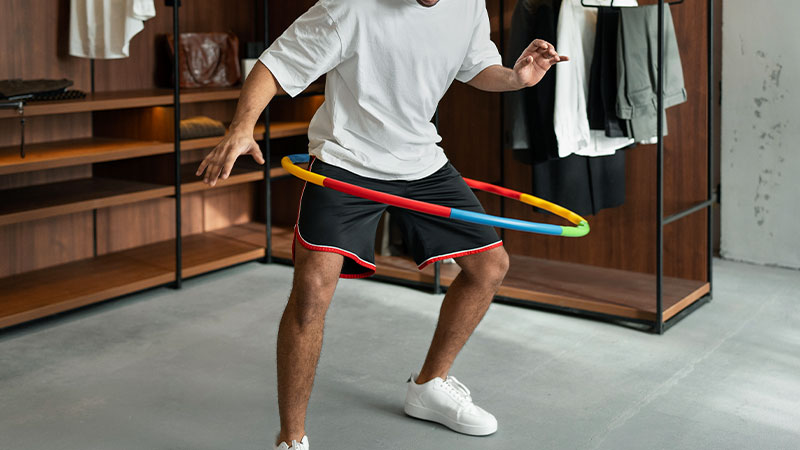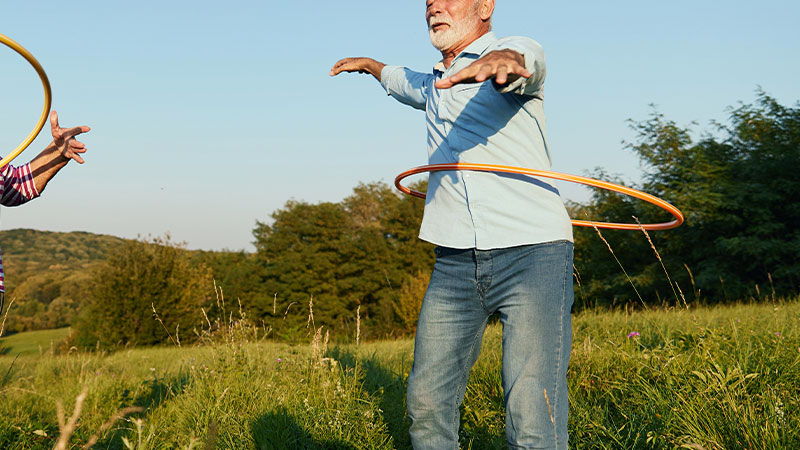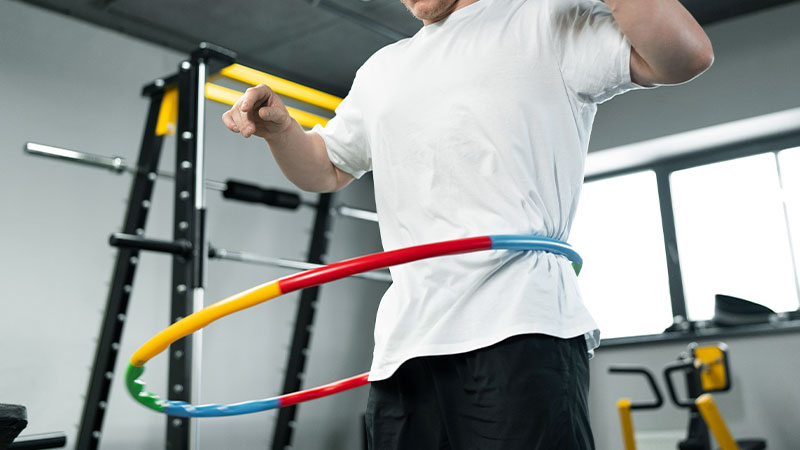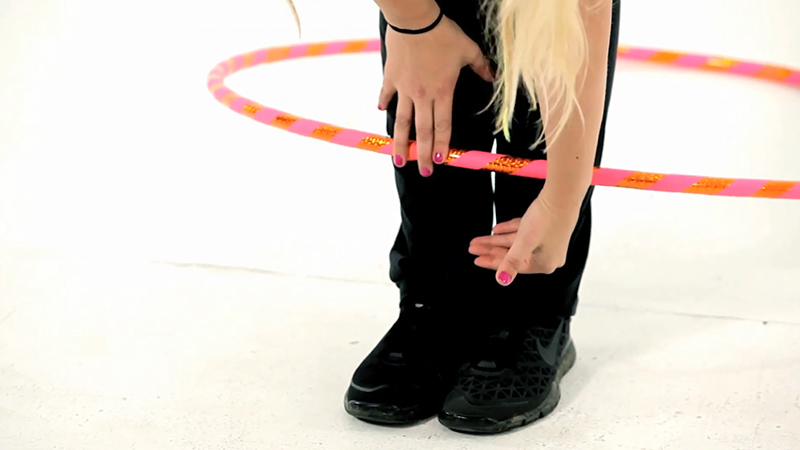Looking to add some fun and fitness to your routine? Hula hoop workouts are a fantastic way for seniors to stay active and energized.
In this article, we’ll explore seven hula hoop exercises tailored specifically for older adults, helping you boost your strength, flexibility, and overall well-being.
Engaging in hula hoop exercises not only enhances physical health but also adds a playful twist to your workout regimen.
These low-impact movements are gentle on joints while offering a full-body workout that can improve balance and coordination.
Whether you’re a beginner or have some experience, these hula hoop exercises are designed to cater to all fitness levels, making it easy for you to enjoy the benefits of exercise in a fun and enjoyable way.
Ready to spin your way to better health and vitality? Let’s dive into these seven hula hoop workouts curated with seniors in mind, helping you embrace a more active and vibrant lifestyle.

Benefits of Hula Hooping for Seniors
Hula hooping offers a wide array of benefits for seniors, helping improve physical health and overall well-being. Here are some specific advantages that hula hooping can provide for seniors:
Improved Core Strength
Engaging in hula hoop workouts can significantly enhance core strength for seniors. The continuous movement of the hoop requires abdominal and lower back muscle engagement, leading to improved stability and muscle tone in the core area.
Enhanced Cardiovascular Fitness
Hula hooping is an excellent way for seniors to boost cardiovascular fitness. The rhythmic motion of hula hooping elevates the heart rate, providing a moderate-intensity aerobic workout that promotes heart health and overall cardiovascular endurance.
Calorie Burning and Weight Loss
Seniors can benefit from hula hooping as a calorie-burning exercise that aids in weight management. By incorporating hula hoop workouts into their routine, seniors can burn calories and support weight loss goals while enjoying a fun and engaging activity.
Improved Balance and Coordination
Practicing hula hoop exercises can help seniors improve balance and coordination. The movements involved in hula hooping require body awareness and coordination, which can contribute to better balance and stability, reducing the risk of falls.
Enhanced Mental Health
Hula hooping offers not only physical benefits but also mental health advantages for seniors. The rhythmic and repetitive nature of hula hooping can act as a form of stress relief, promoting relaxation, reducing anxiety, and enhancing overall mental well-being.
Versatility and Convenience
One of the key benefits of hula hooping for seniors is its versatility and convenience. Hula hoop workouts can be easily modified to suit different fitness levels and can be done in the comfort of your own home or outdoors, providing a flexible exercise option for seniors.
Fun Factor
Engaging in hula hoop workouts can bring joy and entertainment to seniors’ fitness routines. The playful nature of hula hooping makes it a fun and enjoyable way to stay active, encouraging regular exercise participation and promoting a more active and vibrant lifestyle.
Exploring the Science Behind Hula Hooping
Hula hooping, particularly with weighted hoops, has been studied to determine its effectiveness in aiding weight loss and improving fitness levels. Let’s delve into the scientific aspects behind hula hooping.
Do Weighted Hula Hoops Work?
Research suggests that using weighted hula hoops can lead to significant benefits such as enhanced core strength, cardiovascular fitness, weight loss, and improved balance and coordination.
The added resistance from the weights intensifies the workout, resulting in more calories burned and increased muscle engagement. This can be particularly beneficial for seniors looking to boost their overall fitness levels.
Who Can Benefit from Hula Hooping?
Hula hooping is a low-impact exercise that can offer advantages to people of all ages, including seniors. Its rhythmic motion helps improve coordination, flexibility, and stamina while being gentle on the joints.
Seniors looking to add variety to their exercise routine, improve core strength, and enhance cardiovascular fitness can greatly benefit from incorporating hula hooping into their workout regimen.
7 Hula Hoop Exercises Ideal for Seniors
1. Waist Hooping

To start, waist hooping is a classic and effective hula hoop exercise for seniors. It’s a great way to engage your core muscles, improve balance, and boost cardiovascular fitness.
Try hooping around your waist for a few minutes each day to get started. Next, you can progress to arm hooping, which helps enhance upper body strength and coordination.
This exercise involves keeping the hoop spinning around your arms instead of your waist, providing a new challenge for seniors looking to diversify their hula hoop workout routine.
2. Squatting While Waist Hooping

Combining squats with waist hooping adds a new challenge to your workout routine. It helps strengthen your lower body muscles, especially the quads and glutes.
Remember to maintain proper form while squatting to avoid injury and maximize the benefits. Engaging in hula hoop waist hooping while performing squats can provide a dynamic way to target and tone your lower body muscles, particularly the quads and glutes.
Focus on executing squats with correct form to prevent any potential injuries and optimize the workout’s effectiveness.
3. Lunging While Waist Hooping

Lunging while waist hooping is an excellent way to work on balance, coordination, and leg strength.
The dynamic movement of lunging along with hooping engages multiple muscle groups simultaneously, making it a full-body exercise.
This exercise can also help improve stability and flexibility in seniors, reducing the risk of falls and enhancing overall mobility. It’s a fun and effective way to incorporate hula hooping into their fitness routine.
4. Walking While Waist Hooping

Walking while waist hooping is a fun and functional exercise for seniors. It not only elevates your heart rate but also enhances coordination and spatial awareness.
This exercise is a great way to keep moving while enjoying the rhythmic motion of hula hooping. It is recommended to start with short sessions and gradually increase the duration as your endurance improves.
Remember to engage your core muscles to maintain balance and stability while waist hooping. This low-impact workout can help improve flexibility and strengthen your core muscles over time.
5. Hula Hooping in a “Pencil Pose”

The “pencil pose” involves standing tall with your feet together while hooping around your waist. This exercise helps improve posture, strengthen your core, and focus on stability.
It’s a simple yet effective way to engage your abdominal muscles. Additionally, the “pencil pose” can be modified by incorporating side-to-side movements to further enhance core engagement and balance for seniors during their hula hoop workouts.
6. Hula Hooping Around the Knees

Hula hooping around the knees is a low-impact exercise that targets the muscles in your legs and hips.
This exercise can help improve joint mobility, enhance circulation in the lower body, and add variety to your hula hoop workout routine.
It’s a great way for seniors to strengthen their lower body and improve balance. Plus, it’s fun and easy to do indoors or outdoors, making it a versatile option for staying active.
7. Hula Hooping Around the Neck
While more advanced, hooping around the neck offers a unique challenge for seniors looking to level up their hula hoop workout.
This exercise requires control and neck stability, benefiting neck muscles and overall coordination. Ensure proper technique and start with shorter intervals before extending the duration.
Gradually increase the time spent hooping around the neck to avoid strain and maximize benefits for senior fitness. Focus on maintaining good posture and breathing throughout the exercise to enhance its effectiveness.
Addressing Common Concerns and Misconceptions
What Can Hula Hooping 30 Minutes a Day Do?
- Strengthen Core Muscles: Hula hooping for 30 minutes daily can effectively engage your core muscles, helping to enhance strength and stability. This consistent workout may target abdominal muscles, obliques, and lower back muscles.
- Burn Calories: Regular hula hooping for 30 minutes can be a fun way to burn calories. It’s estimated that you can burn about 165-200 calories in 30 minutes of hula hooping, which makes it a great addition to your fitness routine for weight management.
Are Hula Hoops Good for Fitness?
- Aerobic Exercise: Hula hooping is an excellent form of aerobic exercise that elevates your heart rate, promoting cardiovascular health and endurance. It’s a low-impact workout that can improve circulation and overall fitness levels.
- Muscle Toning: Hula hooping engages various muscle groups, including the core, hips, and legs. As you spin the hoop, you activate and tone these muscles, leading to improved strength, flexibility, and coordination.
- Strain on Joints: Using weighted hula hoops may put extra strain on your joints, particularly if you have existing joint issues. It’s essential to start with lighter weights and gradually increase as your strength and endurance improve to prevent joint discomfort.
- Risk of Injury: Excessive use or incorrect form while using weighted hula hoops can increase the risk of injury, especially to the back, hips, and knees. It’s crucial to maintain proper posture and technique to minimize the risk of strain or injury while hula hooping with weights.
Frequently Asked Questions
Is hula hooping safe for seniors?
Hula hooping is a safe and effective exercise for seniors, promoting mobility, flexibility, muscle tone, and strength without putting excessive strain on joints.
How many calories can you burn with hula hooping?
On average, women can burn approximately 165 calories in 30 minutes of hula hooping, while men can burn around 200 calories, making it a comparable aerobic activity for calorie burning.
Does hula hooping help flatten the stomach?
Hula hooping can aid in reducing belly fat and toning abdominal muscles, contributing to a leaner and stronger core when combined with a balanced fitness routine and healthy diet.
Are there any risks with using a weighted hula hoop?
Using a weighted hula hoop may lead to strain on the spine and lower back muscles due to repetitive movements, potentially causing discomfort or injury if not used correctly or excessively.
Conclusion: Revitalizing Your Workout Regime with Hula Hooping
You’ve discovered the myriad benefits of hula hoop workouts for seniors, from enhancing strength and flexibility to boosting overall well-being.
By engaging in a variety of exercises that target different muscle groups, you can revitalize your fitness routine. Remember to incorporate hula hooping into your daily regimen and combine it with other activities for a holistic approach to staying active.
Addressing common concerns and misconceptions about hula hooping, such as its impact on core muscles, calorie burning potential, and muscle toning benefits, can help you make the most of this fun and effective workout.
Be mindful of using proper form and avoiding excessive strain on joints, especially when using weighted hula hoops, to minimize the risk of injury.
I am a fitness instructor and I have been in the industry for 9 years. I have a passion for health and fitness.
I am a fitness instructor with over 9 years of experience in the industry. My passion is health and fitness and I would love to share my knowledge with you!